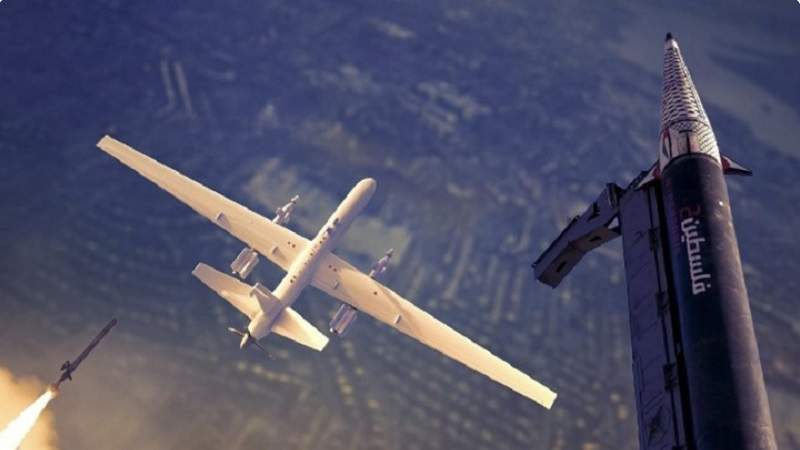Yemeni Role Shifts Regional Power Balance: Analysts Say Sanaa’s Entry into Battle Shattered US Calculations
Lebanese military expert Brig. Gen. Omar Maarabouni described Yemen’s entry into the confrontation with the Israeli enemy as a “strategic shock” that overturned American and Zionist calculations, marking one of the most significant military surprises in the region since the 1973 October War.
Maarabouni said indicators suggest that Yemen’s Armed Forces may soon announce a new operation, describing the current escalation as part of an ongoing regional deterrence equation that began with the Al-Aqsa Flood operation on October 7, 2023.
He explained that the recent sirens in Umm al-Rashrash (Eilat) could be linked to a Yemeni missile or drone launch, noting that the timing coincides with the second anniversary of Al-Aqsa Flood—an event that reshaped the Arab-Israeli conflict and introduced “the promised liberation front” led by Yemen’s direct military and political support for Gaza.
Two Conflicting Views of Resistance
Maarabouni highlighted the ideological divide in interpreting the Gaza operation: one camp views it as a “reckless adventure” rooted in Western or pro-Zionist narratives, while the other regards it as a religious, moral, and humanitarian duty to resist oppression—an interpretation Yemen has embodied through action rather than rhetoric.
He stressed that Yemen’s alignment with the latter view positioned it at the forefront of nations providing direct political, military, and popular support to Palestine, transforming the country into a decisive factor in the regional deterrence balance.
Strategic and Technological Leap
The Lebanese expert described Yemen’s entry into the confrontation as “the third and most significant strategic surprise” in modern Arab-Zionist conflict history.
Neither Washington nor the entity, he said, anticipated that Yemen would engage at such depth—establishing air and naval deterrence equations that disrupted US and Israeli planning.
Maarabouni called Yemen’s model a rare example of modern warfare synergy, where public mobilization, political decision-making, and advanced military innovation operate in harmony. He noted that Yemeni ballistic and hypersonic missiles—capable of reaching occupied Palestine over 2,000 kilometers away—demonstrate unprecedented indigenous development despite years of blockade and war.
He added that Yemeni forces have even managed to bypass American and Zionist detection systems and deploy multi-warhead missiles—capabilities typically reserved for major industrial powers.
Redefining Naval Deterrence
On the maritime front, Maarabouni said Yemen’s naval operations in the Red Sea and Gulf of Aden redefined regional sovereignty. Yemeni forces, he explained, compelled commercial and military vessels linked to the Israeli enemy and its allies to retreat or alter routes, while direct confrontations with US warships and aircraft carriers forced Washington to redeploy its fleets.
“The withdrawal of three US naval groups from the area,” he said, “marks a turning point in modern military history and signals the rise of a new regional power equation.”
Maarabouni concluded that Yemen’s growing capabilities—combined with steadfast public and political will—represent a moral and strategic victory for all resistance fronts.
Parallel Political Perspective
Meanwhile, Mohammed al-Farrah, member of Ansarullah’s Political Bureau, said the Yemeni people have embodied the Qur’anic stance in supporting Gaza since the first hours of the Al-Aqsa Flood operation.
In statements on his X (formerly Twitter) account, al-Farrah said Yemenis immediately took to the streets on October 7, 2023, to bless and support the Palestinian resistance and have continued to stand by Gaza through protests, fundraising, and direct military backing.
He described Yemen’s unwavering position as divinely guided, ensuring it does not share in “the crime of silence” over Israeli and American atrocities in Gaza.
“Remaining silent in the face of oppression,” al-Farrah wrote, “is complicity in sin. The Zionist entity does not triumph by its power, but by the world’s silence.”
He added that despite overwhelming military and media power, the Israeli enemy faces psychological collapse and existential fear, intensified by global solidarity movements such as the Freedom Flotilla initiatives.
Al-Farrah concluded that the continued resilience of Gaza’s people and Yemen’s steadfastness have proven that faith, awareness, and resistance are reshaping the region’s future—signaling that the fall of the Zionist project is only a matter of time.
Since October 2023, Yemen has expanded its political and military involvement in the Gaza conflict in support of the Palestinian resistance, launching long-range drone and missile operations toward occupied territories and targeting Israeli-linked shipping in the Red Sea and Arabian Sea.
These operations, combined with large-scale popular mobilization across Yemen, have positioned Sana’a as a key member of the Axis of Resistance, altering US and Zionist strategic assessments and redefining deterrence dynamics in the Middle East.

